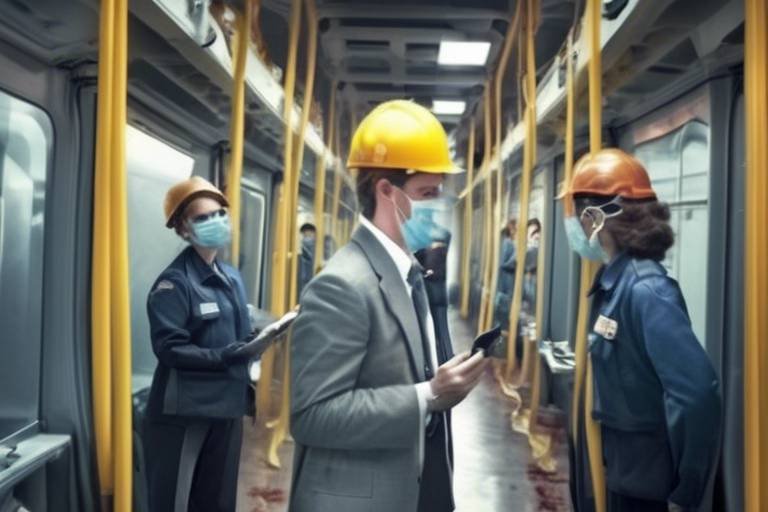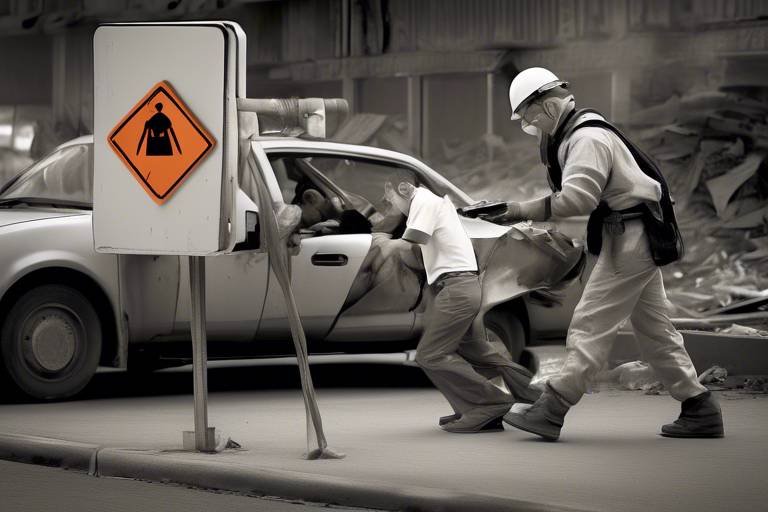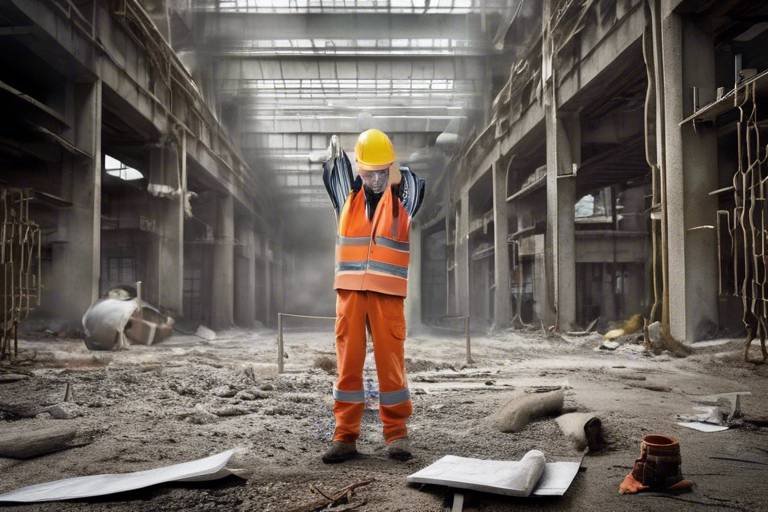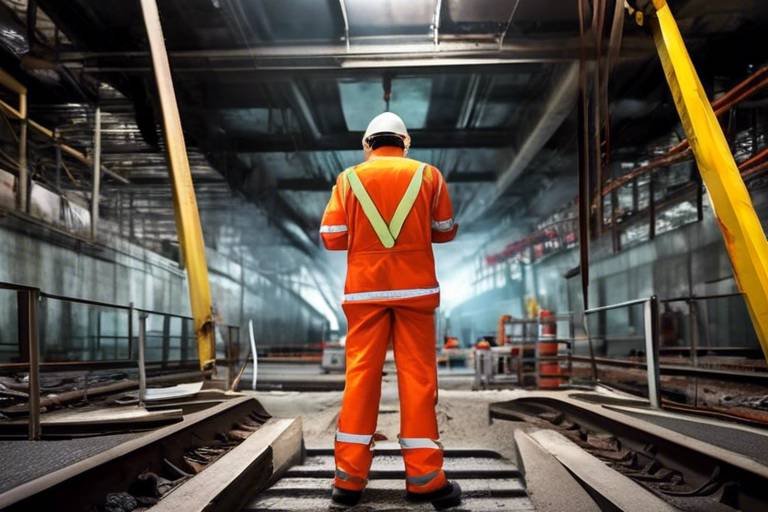The Impact of Human Behavior on Safety Protocols
In today's fast-paced world, the significance of safety protocols cannot be overstated. They are the backbone of any organization, ensuring that employees are protected from potential hazards. However, the effectiveness of these protocols often hinges on one crucial factor: human behavior. Understanding how individuals interact with safety measures is essential for creating a culture of safety that resonates throughout an organization.
Human behavior is influenced by a myriad of factors, including psychological, social, and organizational elements. For example, consider a construction site where safety helmets are mandatory. While the protocol is clear, the real challenge lies in ensuring that every worker adheres to this rule. Why do some people follow safety protocols diligently while others disregard them? This question leads us to delve deeper into the psychology behind safety compliance.
One of the key psychological factors is the concept of risk perception. Individuals often underestimate the dangers associated with their tasks, leading to a false sense of security. This cognitive bias can result in neglecting safety measures. Additionally, the fear of being seen as overly cautious or the desire to fit in with peers can pressure individuals to prioritize social acceptance over safety. Such dynamics highlight the need for organizations to foster an environment where safety is valued and prioritized.
Furthermore, social influences play a significant role in shaping safety behavior. Have you ever noticed how group dynamics can sway individual decisions? In many cases, peer pressure can lead to either positive or negative outcomes. When safety is championed by a group, individuals are more likely to comply. Conversely, if a group downplays safety concerns, others might follow suit, jeopardizing their well-being. This emphasizes the importance of cultivating a positive safety culture where everyone feels empowered to speak up about safety concerns.
Leadership is another critical factor in this equation. Effective leaders set the tone for safety expectations and behaviors within their teams. They are responsible for not only establishing safety protocols but also for actively promoting them. When leaders demonstrate a commitment to safety, it resonates with employees, fostering a culture where safety is everyone's responsibility. A leader's actions can inspire others to take safety seriously, creating a ripple effect throughout the organization.
Moreover, clear communication strategies are vital for ensuring that safety protocols are understood and followed. It’s not enough to simply have rules in place; organizations must ensure that all team members know their roles and responsibilities. Regular training sessions, safety meetings, and accessible resources can enhance understanding and compliance. The more informed employees are, the more likely they are to engage with safety protocols actively.
Training and development programs also play a significant role in shaping safety behavior. When employees are equipped with the knowledge and skills necessary to follow safety protocols, they are more likely to do so. Comprehensive training fosters a proactive approach to workplace safety, encouraging individuals to think critically about their actions and the potential risks involved.
As we explore the intersection of human behavior and safety protocols, it becomes clear that understanding the psychological and social dynamics at play is crucial. By addressing these factors, organizations can improve compliance and enhance overall safety culture.
- What are the main factors influencing safety compliance?
The main factors include psychological elements like risk perception, social influences such as peer pressure, and organizational factors like leadership and communication. - How can organizations improve safety culture?
Organizations can improve safety culture by fostering open communication, providing comprehensive training, and ensuring that leaders model safe behaviors. - Why is leadership important for safety protocols?
Leadership is crucial as it sets the tone for safety expectations and behaviors, influencing how employees perceive and adhere to safety measures. - What role does training play in safety compliance?
Training equips employees with the necessary knowledge and skills to follow safety protocols, fostering a proactive approach to safety.

The Psychology of Safety Compliance
Understanding the psychological factors that drive individuals to adhere to or neglect safety protocols is essential for improving compliance and enhancing overall safety culture in organizations. At the core of this understanding lies the recognition that human behavior is not just a matter of following rules; it’s deeply influenced by a myriad of factors including emotions, perceptions, and cognitive biases. For instance, when individuals perceive a low risk in their environment, they might be less likely to follow safety protocols. This can lead to a dangerous mindset where safety measures are viewed as optional rather than mandatory.
Moreover, the concept of cognitive dissonance plays a significant role in safety compliance. When employees are aware of safety protocols but choose to ignore them, they often experience a psychological conflict. This dissonance can drive them to rationalize their behavior, leading to a cycle of neglect. To combat this, organizations must create an environment where adherence to safety measures is not only encouraged but celebrated. This can be achieved through positive reinforcement strategies, where employees are recognized for their commitment to safety.
Another crucial aspect to consider is the role of motivation. Individuals are more likely to comply with safety protocols when they feel personally invested in their safety and the safety of their colleagues. This motivation can stem from various sources, including personal values, organizational culture, and peer influence. For example, when employees see their leaders actively engaging in safety practices, they are more likely to follow suit, creating a ripple effect throughout the organization.
Additionally, the use of behavioral nudges can significantly enhance safety compliance. These are subtle prompts that encourage safe behavior without restricting freedom of choice. For instance, placing reminders or visual cues in high-risk areas can trigger the necessary actions that lead to safer practices. This approach taps into the psychology of habit formation, where repeated exposure to safety reminders can eventually lead to automatic compliance.
In summary, the psychology of safety compliance is multifaceted, involving emotional, cognitive, and social dimensions. By understanding these psychological underpinnings, organizations can develop more effective strategies to foster a culture of safety. Implementing training programs that focus on the psychological aspects of safety can empower employees, making them more aware of their behaviors and the impact those behaviors have on their safety and that of others.
- What are the main psychological factors affecting safety compliance? The main factors include risk perception, cognitive dissonance, motivation, and the influence of social norms.
- How can organizations improve safety compliance? Organizations can improve safety compliance by fostering a positive safety culture, providing regular training, and utilizing behavioral nudges.
- Why is leadership important in safety compliance? Leadership sets the tone for safety expectations and behaviors, significantly influencing employee adherence to safety protocols.

Social Influences on Safety Behavior
When we think about safety in the workplace, it’s easy to focus solely on the protocols and procedures that are put in place. However, the social dynamics within an organization can have a profound impact on how those protocols are perceived and followed. Have you ever noticed how people tend to adjust their behavior based on the actions of those around them? This is particularly true in the context of safety. Whether it’s the subtle nod of approval from a colleague for skipping a safety measure or the collective commitment to following protocols, social influences are everywhere.
One of the most significant factors in this social influence is peer pressure. In a work environment, individuals often look to their coworkers for cues on how to behave. If the majority of the team is diligent about wearing protective gear, for instance, new employees are likely to adopt that same behavior. Conversely, if a few employees neglect safety measures without facing consequences, it can create a ripple effect, leading others to question whether those measures are truly necessary. This phenomenon can be likened to a game of dominoes—one careless act can topple the commitment to safety across the team.
Moreover, group norms play a crucial role in shaping safety behavior. These unwritten rules dictate what is considered acceptable and can vary widely from one workplace to another. For example, in a high-stakes environment like construction, the norm might be to always wear a hard hat, while in a less hazardous setting, employees might feel comfortable forgoing it. Understanding these social norms is essential for organizations aiming to cultivate a robust safety culture. They must actively work to establish norms that prioritize safety and encourage open discussions about safety practices.
Another key element is the role of leadership. Leaders set the tone for safety expectations, and their behavior can significantly influence how safety protocols are perceived and followed. When leaders consistently demonstrate a commitment to safety—whether through compliance with safety measures or by actively engaging in safety training—they send a powerful message to their team. Employees are more likely to adopt positive safety behaviors when they see their leaders prioritizing safety. In contrast, if leaders are lax about safety practices, it can lead to a culture of negligence where employees feel justified in ignoring protocols.
To further illustrate these social influences, consider the following table that outlines various social factors and their impact on safety behavior:
| Social Factor | Impact on Safety Behavior |
|---|---|
| Peer Pressure | Encourages adherence to safety protocols or fosters neglect. |
| Group Norms | Shapes expectations around safety compliance; can be positive or negative. |
| Leadership Behavior | Sets the standard for safety practices and influences team attitudes. |
| Communication | Facilitates understanding of safety protocols and encourages feedback. |
Ultimately, fostering a culture that prioritizes safety requires a multifaceted approach that addresses these social influences. Organizations must actively engage their workforce in conversations about safety, encourage positive peer interactions, and ensure that leadership exemplifies the safety standards they wish to see. By doing so, they not only enhance compliance with safety protocols but also cultivate an environment where safety is truly valued. So, next time you think about safety measures, remember that it's not just about the rules—it's about the people who follow them.
- How can peer pressure positively influence safety behavior? Peer pressure can encourage team members to comply with safety protocols by creating a culture of accountability.
- What role does leadership play in safety compliance? Effective leadership sets a positive example and establishes clear expectations for safety practices within the organization.
- How can organizations improve safety culture? Organizations can improve safety culture by fostering open communication, providing regular training, and encouraging feedback from employees.

The Role of Leadership in Safety Culture
Leadership plays a crucial role in establishing and maintaining a robust safety culture within any organization. The behaviors and attitudes of leaders set the tone for the entire team, influencing how safety protocols are perceived and adhered to. When leaders prioritize safety, it sends a powerful message that resonates throughout the organization. This commitment to safety can be likened to a ripple effect; when leaders demonstrate a strong dedication to safety measures, it encourages employees at all levels to follow suit. But what does this really look like in practice?
One of the most effective ways leaders can foster a positive safety culture is through active engagement. This means not just talking the talk but walking the walk. Leaders should participate in safety training sessions, conduct regular safety audits, and be present during safety meetings. By being actively involved, leaders show that they value safety, which can motivate employees to prioritize it as well. Additionally, leaders should encourage open communication about safety concerns. Employees need to feel comfortable reporting hazards or unsafe practices without fear of retribution. When leaders create an environment where feedback is welcomed, it can lead to significant improvements in safety protocols.
Another essential aspect of leadership in safety culture is recognition and reinforcement. Acknowledging employees who adhere to safety protocols not only boosts morale but also reinforces the importance of these behaviors. For instance, leaders might implement a rewards program that highlights individuals or teams who consistently follow safety guidelines. This kind of recognition can be a powerful motivator, encouraging others to follow suit. Moreover, leaders should ensure that safety protocols are integrated into the organization's overall values and mission. When safety is viewed as a core value, it becomes a fundamental part of the organizational identity, rather than just an obligation.
To illustrate the impact of leadership on safety culture, consider the following table that outlines key leadership behaviors and their effects on employee safety compliance:
| Leadership Behavior | Effect on Safety Compliance |
|---|---|
| Active Participation in Safety Initiatives | Increases employee engagement and commitment to safety protocols |
| Open Communication Channels | Encourages reporting of unsafe practices and fosters a culture of transparency |
| Recognition of Safe Practices | Boosts morale and motivates others to adhere to safety measures |
| Integration of Safety into Organizational Values | Establishes safety as a core aspect of the organizational identity |
Ultimately, effective leadership is about more than just enforcing rules; it’s about creating a culture where safety is a shared responsibility. Leaders must be consistent in their messaging and actions, ensuring that safety is always at the forefront of organizational priorities. By doing so, they not only protect their employees but also enhance overall productivity and morale. In a world where workplace safety is paramount, the role of leadership cannot be overstated. When leaders champion safety, they pave the way for a culture where everyone feels empowered to contribute to a safer work environment.
Frequently Asked Questions
- What is the most important role of leadership in safety culture?
The most important role is to set a positive example and actively engage in safety practices, reinforcing the importance of safety protocols among all employees. - How can leaders encourage open communication about safety?
Leaders can encourage open communication by creating an environment where employees feel safe to report hazards without fear of retribution and by regularly soliciting feedback on safety practices. - What are some effective ways to recognize safe practices?
Implementing a rewards program or publicly acknowledging individuals and teams who adhere to safety protocols can effectively recognize and reinforce safe practices.

Communication Strategies for Safety
Effective communication is the backbone of any successful safety protocol. Without it, even the most comprehensive safety measures can falter. Imagine trying to assemble a complex piece of furniture without the instruction manual; that’s how employees feel when safety protocols aren’t clearly communicated. It’s crucial to ensure that every team member understands their role in maintaining a safe environment. This means not only disseminating information but also ensuring it’s comprehensible and actionable.
One of the most effective strategies is to utilize visual aids. Infographics, charts, and posters can simplify complex information, making it easier for employees to digest and remember. For instance, a simple chart illustrating the steps for using safety equipment can be much more effective than a lengthy manual. Additionally, regular safety meetings can serve as an interactive platform where employees can ask questions and express concerns. This two-way communication fosters a culture of safety and encourages proactive engagement.
Moreover, leveraging technology can enhance communication efficiency. Digital platforms, such as mobile apps or intranet systems, can provide real-time updates and reminders about safety protocols. Imagine receiving a push notification about a safety drill or an update on new safety measures right on your phone! This immediacy not only keeps safety at the forefront of employees’ minds but also demonstrates the organization’s commitment to a safe working environment.
Furthermore, it’s essential to tailor communication strategies to fit the diverse workforce. Different individuals may respond better to various forms of communication. For example, while some may prefer detailed written instructions, others might benefit from hands-on demonstrations. Understanding these preferences can significantly enhance the effectiveness of safety communication. Here’s a quick overview of different communication methods:
| Method | Description | Best For |
|---|---|---|
| Visual Aids | Infographics, charts, and posters that simplify safety information. | Visual learners and quick reference. |
| Meetings | Regular discussions that allow for questions and feedback. | Building a safety culture and team engagement. |
| Digital Platforms | Apps and intranet systems for real-time updates. | Immediate access to safety information. |
| Hands-On Training | Practical demonstrations of safety protocols. | Kinesthetic learners and new employees. |
In conclusion, effective communication strategies are vital for ensuring that safety protocols are understood and adhered to. By integrating various methods tailored to the workforce's needs, organizations can create a culture of safety where every employee feels empowered and informed. After all, when it comes to safety, clarity is not just beneficial; it’s essential.
- What are the key components of effective safety communication?
Key components include clarity, consistency, accessibility, and engagement. Ensuring that information is easy to understand and readily available is crucial. - How often should safety meetings be held?
Regular safety meetings should be held at least monthly, but more frequent meetings may be necessary depending on the work environment and ongoing safety concerns. - What role does feedback play in safety communication?
Feedback is essential for continuous improvement. It helps organizations identify gaps in communication and adjust strategies accordingly.

Training and Development Programs
When it comes to fostering a culture of safety within an organization, are absolutely essential. These programs serve as the backbone of any effective safety protocol, equipping employees with the necessary knowledge and skills to navigate their work environments safely. Imagine stepping into a new job without any guidance on safety measures; it would be like sailing a ship without a map, right? That's why structured training programs are crucial—they provide the roadmap that leads to a safer workplace.
Moreover, these programs should not be one-size-fits-all. Different roles within an organization come with unique safety challenges. For instance, the safety protocols required in a manufacturing plant differ significantly from those in an office environment. Therefore, it’s vital to tailor training sessions to fit the specific needs of various teams. This tailored approach not only enhances understanding but also increases the likelihood of compliance. Think of it as fitting a key to a lock; the right training can unlock the potential for a safer work culture.
Additionally, integrating interactive elements into training can significantly boost engagement and retention. Workshops, simulations, and even role-playing scenarios can make learning about safety protocols more dynamic and memorable. For example, consider a scenario where employees partake in a fire drill simulation. This hands-on experience not only reinforces the importance of evacuation procedures but also instills confidence in employees, making them more likely to act decisively in an emergency.
Regularly updating these training programs is equally important. As industries evolve, so do safety standards and protocols. Keeping training materials current ensures that employees are always aware of the latest practices and technologies. Organizations should schedule periodic reviews of their training content, perhaps on an annual basis, to align with new regulations or advancements in safety equipment. This proactive approach demonstrates a commitment to safety that resonates with employees, fostering a culture where safety is prioritized.
Finally, feedback mechanisms should be integrated into training programs. After completing a training session, employees should have the opportunity to share their thoughts on the effectiveness of the training and any areas for improvement. This feedback loop not only enhances the training but also empowers employees, making them feel valued and involved in the safety culture. It’s akin to a gardener tending to their plants; with the right care and adjustments, the garden—much like the safety culture—will flourish.
In summary, well-structured training and development programs are pivotal in shaping a safe work environment. By focusing on tailored content, interactive learning, regular updates, and feedback mechanisms, organizations can cultivate a proactive safety culture that not only meets compliance standards but also protects the well-being of every employee.
- What are the key components of an effective training program? An effective training program should include tailored content, interactive learning methods, regular updates, and feedback mechanisms.
- How often should training programs be updated? Training programs should be reviewed and updated at least annually to align with the latest safety standards and practices.
- Why is employee feedback important in training programs? Employee feedback helps improve the training process and fosters a sense of involvement and value among staff, which can enhance overall safety culture.

Behavioral Economics and Safety Decisions
When we think about safety in the workplace, we often focus on rules, regulations, and protocols. However, the truth is that human behavior plays a crucial role in how these safety measures are implemented and adhered to. This is where the fascinating field of behavioral economics comes into play. It dives deep into the psychology of decision-making, revealing why people sometimes make choices that seem irrational or counterproductive when it comes to safety.
Behavioral economics suggests that our decisions are not always based on logical reasoning. Instead, they are heavily influenced by cognitive biases, emotions, and social factors. For instance, consider the concept of loss aversion, which posits that people tend to prefer avoiding losses rather than acquiring equivalent gains. In a safety context, this might mean that an employee is more likely to follow a safety protocol if they perceive a significant risk of losing something valuable—like their job or health—rather than if they are simply trying to gain a reward.
Moreover, the framing effect can significantly impact safety decisions. How information is presented can sway an individual's choice. For example, if a safety protocol is framed as a way to prevent accidents (a loss) rather than as a way to promote efficiency (a gain), employees might be more likely to comply. This highlights the importance of how safety messages are communicated within an organization.
Another fascinating aspect is the role of social norms. People are inherently social beings, and their behaviors are often influenced by the actions of their peers. If an employee observes their colleagues neglecting safety protocols, they may feel pressured to conform, even if they know it's not the right choice. This is why fostering a strong safety culture is essential; it can create positive social norms that encourage compliance. Organizations can leverage this by implementing strategies such as:
- Highlighting positive safety behaviors through recognition programs.
- Creating peer-led safety committees to promote accountability.
- Encouraging open discussions about safety concerns without fear of repercussion.
Furthermore, the concept of bounded rationality plays a role in safety decisions. Employees may not always have access to all the information needed to make the best choices regarding safety protocols. They may also be overwhelmed by the sheer volume of information, leading to decision fatigue. This is where organizations can step in to simplify the decision-making process by providing clear, concise guidelines and ensuring that employees have access to necessary resources and training.
In conclusion, understanding the interplay between behavioral economics and safety decisions is vital for organizations aiming to enhance their safety culture. By recognizing the cognitive biases and social influences at play, leaders can tailor their approaches to safety compliance, ultimately creating a safer work environment. The next time you think about safety protocols, remember that it’s not just about the rules; it’s about the people who follow them and the intricate web of influences that guide their decisions.
- What is behavioral economics? Behavioral economics is a field that studies how psychological factors affect economic decision-making, often leading to irrational choices.
- How does loss aversion impact safety decisions? Loss aversion suggests that people are more motivated to avoid losses than to achieve gains, influencing their compliance with safety protocols.
- What role do social norms play in safety compliance? Social norms can encourage or discourage adherence to safety protocols based on the behaviors of peers.
- How can organizations improve safety compliance? Organizations can improve compliance by simplifying decision-making, fostering a positive safety culture, and communicating effectively.

Organizational Factors Affecting Safety Protocols
When we talk about safety protocols within an organization, it's essential to recognize that these protocols don't exist in a vacuum. They are deeply influenced by various organizational factors that shape how employees perceive and engage with safety measures. Think of an organization as a living organism; every part must work in harmony for the whole to function effectively. If one part is weak, it can compromise the entire system, especially when it comes to safety.
One of the primary organizational factors that affect safety protocols is the structure of the organization. A well-defined hierarchy can streamline communication and ensure that safety protocols are effectively disseminated throughout all levels. Conversely, a flat structure may lead to confusion regarding who is responsible for enforcing safety measures. This can result in critical safety protocols being overlooked or ignored.
Additionally, the policies established by the organization play a significant role in shaping safety behaviors. If an organization prioritizes safety in its policies, employees are more likely to take safety seriously. This includes having clear guidelines, regular safety audits, and consequences for non-compliance. On the other hand, if safety is seen as an afterthought, employees may adopt a lax attitude toward protocols, putting themselves and their colleagues at risk.
Another crucial factor is the organizational culture. Culture is often described as the 'personality' of an organization, and it can significantly influence how safety is perceived. A culture that promotes open communication and encourages employees to voice their safety concerns fosters a sense of ownership over safety protocols. In contrast, a culture that punishes mistakes or discourages feedback can lead to a toxic environment where employees are afraid to speak up about safety issues. This can create a dangerous situation where problems go unreported and unresolved.
Moreover, the leadership style within an organization can either enhance or undermine safety protocols. Leaders who actively engage with employees, model safe behaviors, and prioritize safety in their decision-making processes create a climate of trust and accountability. Employees are more likely to follow safety protocols when they see their leaders practicing what they preach. On the flip side, if leaders neglect safety or fail to demonstrate its importance, employees may feel justified in ignoring safety measures themselves.
To illustrate how these factors interact, consider the following table that summarizes key organizational factors affecting safety protocols:
| Organizational Factor | Impact on Safety Protocols |
|---|---|
| Organizational Structure | Affects communication and responsibility for safety enforcement. |
| Policies | Defines the importance of safety and outlines consequences for non-compliance. |
| Organizational Culture | Influences employee attitudes towards safety and willingness to report issues. |
| Leadership Style | Sets the tone for safety expectations and behaviors among employees. |
In conclusion, understanding these organizational factors is crucial for developing effective safety protocols. Organizations that recognize the interplay between structure, policies, culture, and leadership are better positioned to foster a robust safety culture. By aligning these elements, organizations can create an environment where safety is not just a set of rules but a shared value embraced by everyone.
- What role does organizational culture play in safety compliance?
Organizational culture shapes how employees view safety and whether they feel empowered to speak up about safety concerns. - How can leadership improve safety protocols?
Leaders can enhance safety by modeling safe behaviors, prioritizing safety in decision-making, and fostering open communication. - What are some effective communication strategies for safety?
Clear, consistent messaging about safety expectations and responsibilities is vital for ensuring that all employees understand their roles.

The Impact of Work Environment on Safety Behavior
The work environment plays a crucial role in shaping safety behavior among employees. Think of it as the backdrop to a play; while the actors (employees) deliver their lines (safety protocols), the setting (work environment) can either enhance or detract from the performance. A well-designed and supportive work environment fosters a culture of safety, encouraging individuals to prioritize their well-being and that of their colleagues. On the other hand, a chaotic or poorly structured environment can lead to confusion, negligence, and ultimately, accidents.
Consider the physical aspects of the workplace first. Factors such as lighting, noise levels, and the arrangement of equipment can significantly influence how employees perceive safety protocols. For instance, in a dimly lit warehouse, the risk of accidents increases because employees may not see potential hazards clearly. Conversely, a well-lit, organized workspace enhances visibility and allows workers to navigate their surroundings safely. Moreover, ergonomic designs can reduce physical strain, which contributes to a more attentive and engaged workforce.
Social dynamics within the work environment also play a pivotal role. If an organization promotes a culture where safety is openly discussed and prioritized, employees are more likely to feel empowered to adhere to safety protocols. This can be compared to a team sport; when players support each other and communicate effectively, they perform better as a unit. In contrast, if the prevailing attitude is one of indifference or even hostility towards safety measures, employees may feel pressured to overlook protocols, believing that compliance might hinder their productivity or make them appear weak.
Additionally, the organizational structure impacts safety behavior. Hierarchical systems can sometimes stifle communication, leading to a disconnect between management and employees regarding safety concerns. If workers feel that their voices are not heard, they may be less inclined to report unsafe conditions or adhere to safety protocols. A flat organizational structure, where feedback is encouraged and valued, typically leads to a more engaged workforce that takes safety seriously.
| Work Environment Factors | Impact on Safety Behavior |
|---|---|
| Lighting | Improper lighting can obscure hazards, increasing accident risk. |
| Noise Levels | High noise can hinder communication, leading to misunderstandings about safety protocols. |
| Equipment Arrangement | Poorly arranged equipment can create obstacles, making it difficult to follow safety measures. |
| Organizational Culture | A supportive culture encourages reporting and adherence to safety measures. |
To further illustrate the importance of a supportive work environment, consider the concept of “safety climate,” which refers to employees’ perceptions of the importance placed on safety within their organization. A positive safety climate can lead to higher compliance with safety protocols, while a negative climate may result in increased accidents and injuries. Organizations that actively work to improve their safety climate often see a marked improvement in employee morale and productivity, creating a cycle of positive reinforcement.
In conclusion, the work environment is not just a backdrop; it is a dynamic factor that directly influences safety behavior. By prioritizing the physical and social aspects of the workplace, organizations can create an atmosphere where safety is ingrained in the culture, leading to better compliance with safety protocols and ultimately, a safer workplace for everyone.
- What are some key physical factors that affect safety in the workplace?
Physical factors include lighting, noise levels, and the arrangement of equipment, all of which can influence how employees perceive and follow safety protocols.
- How does organizational culture impact safety behavior?
A positive organizational culture promotes open communication about safety, encouraging employees to adhere to protocols and report unsafe conditions.
- What is safety climate?
Safety climate refers to employees' perceptions of the importance placed on safety within their organization, which can significantly influence their behavior regarding safety protocols.
- How can organizations improve their work environment for better safety compliance?
Organizations can improve their work environment by enhancing physical conditions, fostering a positive safety culture, and encouraging open communication about safety concerns.

Feedback Mechanisms for Continuous Improvement
In the realm of safety protocols, feedback mechanisms serve as the lifeblood of continuous improvement. Just as a compass guides a traveler, feedback helps organizations navigate the often tumultuous waters of workplace safety. It’s not merely about having a set of rules; it’s about creating a culture where these rules are regularly assessed, refined, and made relevant to the ever-changing dynamics of the work environment. By actively seeking input from employees, organizations can identify gaps in compliance and areas for enhancement. But how do we effectively implement these feedback mechanisms?
First and foremost, establishing a feedback loop is essential. This involves collecting data from various sources, such as employee surveys, safety audits, and incident reports. For instance, consider the following table that outlines different feedback sources and their potential benefits:
| Feedback Source | Benefits |
|---|---|
| Employee Surveys | Gauge employee perceptions and gather suggestions for improvement. |
| Safety Audits | Identify compliance gaps and assess the effectiveness of current protocols. |
| Incident Reports | Analyze past incidents to prevent future occurrences and refine safety measures. |
Once feedback is collected, the next step is to act on it. This means not just listening but also implementing changes based on the insights gained. Imagine a ship captain who only listens to the crew's concerns but never adjusts the course; the ship would likely veer off track. Similarly, organizations must be willing to adapt and evolve their safety protocols based on employee feedback. This not only enhances safety but also fosters a sense of ownership among employees, making them feel valued and heard.
Moreover, it’s crucial to communicate the changes made as a result of feedback. When employees see that their input leads to tangible improvements, it reinforces the idea that safety is a collective responsibility. Regular updates can be shared through:
- Team meetings
- Newsletters
- Intranet posts
These communication strategies ensure that everyone is on the same page and understands the rationale behind changes to safety protocols. Additionally, organizations can implement a recognition system for employees who actively participate in providing feedback. This could be as simple as acknowledging their contributions in meetings or offering small rewards for insightful suggestions. When employees feel appreciated for their input, they are more likely to engage in the feedback process.
Lastly, it’s important to remember that feedback mechanisms are not a one-time effort but an ongoing process. Regularly scheduled reviews and updates to the feedback system itself can help keep it relevant and effective. By fostering a culture of continuous improvement, organizations can ensure that safety protocols not only meet current standards but also anticipate future challenges.
Q1: What are feedback mechanisms?
A feedback mechanism is a structured process through which organizations gather insights and opinions from employees regarding safety protocols and practices.
Q2: Why is feedback important for safety protocols?
Feedback is crucial because it helps organizations identify areas for improvement, encourages employee engagement, and fosters a culture of safety.
Q3: How can organizations effectively communicate changes made from feedback?
Organizations can communicate changes through team meetings, newsletters, and postings on the company intranet, ensuring transparency and clarity.
Q4: Can feedback mechanisms be implemented in any organization?
Yes, feedback mechanisms can be tailored to fit any organization, regardless of size or industry, making them versatile tools for enhancing safety.
Frequently Asked Questions
- What are the key psychological factors that influence safety compliance?
Psychological factors such as perception of risk, motivation, and individual attitudes towards safety play a crucial role in compliance. When individuals perceive safety protocols as beneficial and relevant, they are more likely to adhere to them. Additionally, intrinsic motivation, such as personal responsibility for safety, can significantly enhance compliance.
- How does social influence affect safety behavior in the workplace?
Social dynamics, including peer pressure and group norms, can have a powerful impact on safety behavior. If employees observe their peers neglecting safety measures, they may feel compelled to do the same. Conversely, a strong safety culture with positive reinforcement can encourage individuals to prioritize safety, fostering a collective commitment to following protocols.
- What role does leadership play in establishing a safety culture?
Leadership is pivotal in setting the tone for safety expectations within an organization. Effective leaders model safe behaviors, communicate the importance of safety, and provide resources for compliance. Their commitment to safety can inspire employees to adopt similar attitudes, creating a culture where safety is prioritized at all levels.
- Why is communication important for safety protocols?
Clear and consistent communication ensures that all team members understand their roles and responsibilities regarding safety. It helps to eliminate confusion and reinforces the importance of adhering to safety protocols. Regular updates and open lines of communication can also foster a culture of safety where employees feel comfortable discussing concerns.
- How do training and development programs enhance safety compliance?
Comprehensive training programs equip employees with the necessary knowledge and skills to follow safety protocols effectively. These programs not only inform employees about safety measures but also engage them in practical exercises, reinforcing their understanding and commitment to maintaining a safe work environment.
- What is the impact of cognitive biases on safety decisions?
Cognitive biases can significantly influence decision-making related to safety. For instance, overconfidence may lead individuals to underestimate risks, while confirmation bias can result in ignoring safety warnings. Understanding these biases is crucial for developing strategies that encourage better safety-related choices among employees.
- How do organizational factors shape employee behavior regarding safety?
The organizational structure, policies, and culture directly influence how employees perceive and engage with safety protocols. A supportive environment that prioritizes safety can enhance compliance, while a lack of clear policies or a punitive culture may discourage adherence to safety measures.
- What role does the work environment play in safety behavior?
The physical and social aspects of the work environment can either promote or hinder safety compliance. A well-designed workspace that minimizes hazards encourages safe behavior, while a chaotic or unsafe environment can lead to increased risks and negligence regarding safety protocols.
- How can feedback mechanisms improve safety protocols?
Feedback mechanisms allow organizations to assess the effectiveness of their safety protocols continuously. By encouraging employees to share their experiences and suggestions, organizations can adapt and improve safety measures, fostering a culture of continuous improvement and engagement in safety practices.



















